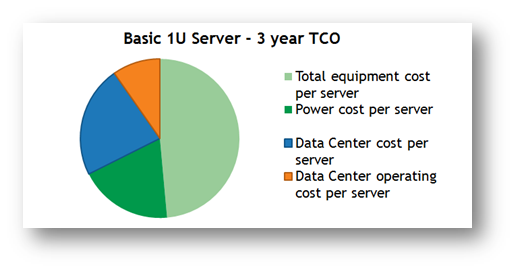Rightsizing Servers to Achieve Cost and Power Savings in the Datacenter
By Dileep Bhandarkar, Ph. D.
Distinguished Engineer
Global Foundation Services, Microsoft
I speak about server rightsizing from time to time at technology conferences, and am surprised that the basic concepts are new to some people in the industry. A lot of people don’t realize the huge performance disparity between the Central Processing Unit (CPU) and disk input/output for instance, and the opportunity that this disparity provides to achieve significant savings by balancing the system.
Rightsizing can clearly reduce the purchase price and the power consumption of a server. But the benefits go beyond the savings in capital expenditure. The lower power consumption has a big impact on the Total Cost of Ownership as shown in the Figure by reducing energy consumption and also reducing its share of the datacenter’s power allocation shown in blue.

Figure: Three-year total cost of ownership of a basic 1U server
It also surprises me that so many IT groups base their purchasing decisions on published benchmark data about processors, even though that data is often generated using system configurations that are completely unrealistic when compared to real-world environments. Most folks sit up and take note when I display the facts about these topics, because the subject is important.
Rightsizing can clearly reduce the purchase price and the power consumption of a server. But the benefits go beyond the savings in capital expenditure. The lower power consumption has a big impact on the Total Cost of Ownership as shown in the Figure.
IT departments are strapped for resources these days, and server rightsizing is something every team can do to stretch their budgets. The point of my presentations and the white paper our team is publishing today is two-fold:
1. To quantify some of the opportunities and potential pitfalls as you look for savings, and
2. To present best practices from our experiences at Microsoft, where the group I lead manages server purchases for the large production data centers behind Microsoft’s wide array of online, live and cloud services.
In a nutshell, the paper describes how we perform detailed analysis of our internal workloads and then select balanced servers that are optimally sized for our production scenarios. It is my hope that IT teams in other companies can use the information in our paper to justify devoting resources to characterizing internal workloads, because that is the basis of an effective rightsizing strategy.
Before I came to Microsoft to manage server definition and purchases I worked on the other side of the fence. For 17 years I focused on processor architecture and performance at Digital Equipment Corporation, and then worked for 12 years at Intel, focusing on performance, architecture, and strategic planning. It’s interesting how now that I’m a hardware customer, the word “performance” encompasses cost effectiveness almost as much as it does throughput and response time. As my colleague Kushagra Vaid and I point out in our paper, when you look up performance in the dictionary it is defined as “how well something performs the functions for which it’s intended”.
Today’s IT departments need to address the cost and power aspects of server performance because saving money and energy efficiency are such important goals for companies these days. We hope this paper, and the data and experiences it shares will help you in this regard.
\db
The paper can be found on GFS’ web site at www.globalfoundationservices.com on the Infrastructure page here and more information on our environmental best practices are posted on Microsoft’s Environmental Sustainability blog post.